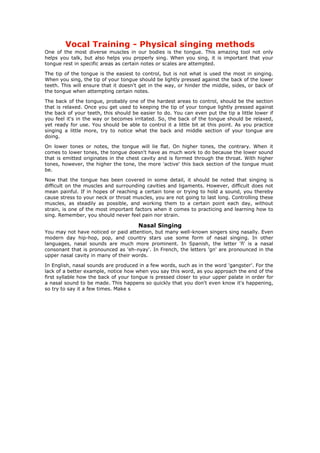
Vocal training
- 1. Vocal Training - Physical singing methods One of the most diverse muscles in our bodies is the tongue. This amazing tool not only helps you talk, but also helps you properly sing. When you sing, it is important that your tongue rest in specific areas as certain notes or scales are attempted. The tip of the tongue is the easiest to control, but is not what is used the most in singing. When you sing, the tip of your tongue should be lightly pressed against the back of the lower teeth. This will ensure that it doesn't get in the way, or hinder the middle, sides, or back of the tongue when attempting certain notes. The back of the tongue, probably one of the hardest areas to control, should be the section that is relaxed. Once you get used to keeping the tip of your tongue lightly pressed against the back of your teeth, this should be easier to do. You can even put the tip a little lower if you feel it's in the way or becomes irritated. So, the back of the tongue should be relaxed, yet ready for use. You should be able to control it a little bit at this point. As you practice singing a little more, try to notice what the back and middle section of your tongue are doing. On lower tones or notes, the tongue will lie flat. On higher tones, the contrary. When it comes to lower tones, the tongue doesn't have as much work to do because the lower sound that is emitted originates in the chest cavity and is formed through the throat. With higher tones, however, the higher the tone, the more 'active' this back section of the tongue must be. Now that the tongue has been covered in some detail, it should be noted that singing is difficult on the muscles and surrounding cavities and ligaments. However, difficult does not mean painful. If in hopes of reaching a certain tone or trying to hold a sound, you thereby cause stress to your neck or throat muscles, you are not going to last long. Controlling these muscles, as steadily as possible, and working them to a certain point each day, without strain, is one of the most important factors when it comes to practicing and learning how to sing. Remember, you should never feel pain nor strain. Nasal Singing You may not have noticed or paid attention, but many well-known singers sing nasally. Even modern day hip-hop, pop, and country stars use some form of nasal singing. In other languages, nasal sounds are much more prominent. In Spanish, the letter 'ñ' is a nasal consonant that is pronounced as 'eh-nyay'. In French, the letters 'gn' are pronounced in the upper nasal cavity in many of their words. In English, nasal sounds are produced in a few words, such as in the word 'gangster'. For the lack of a better example, notice how when you say this word, as you approach the end of the first syllable how the back of your tongue is pressed closer to your upper palate in order for a nasal sound to be made. This happens so quickly that you don't even know it's happening, so try to say it a few times. Make s